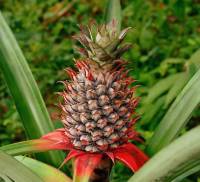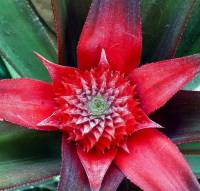This is an old revision of the document!
Pineapple
| Botanical Information |
| Order | Poales |
| Family | Bromeliaceae |
| Genus | Ananas |
| Common Name | Pineapple |
| Species | A. comosus |
Maturity days
Planting Months
| Planting months |
| Jan | Feb | Mar | Apr | May | Jun | Jul | Aug | Sep | Oct | Nov | Dec |
| X | X | X | X | X | X | X | X | X | X | X | X |
Permaculture uses
| Permaculture uses |
| Usage 1 | Usage 2 | Usage 3 |
| | | Fruit |
| Growing Condition | Comment |
| Drought Tolerant | Yes |
| Humidity tolerant | No |
| Planting area | Ground |
| Sunlight | Full_sun |
Photos
Grows in Rollingstone north of Townsville
The pineapple[2][3] (Ananas comosus) is a tropical plant with an edible fruit and the most economically significant plant in the family Bromeliaceae. Pineapples grow as a small shrub; the individual flowers of the unpollinated plant fuse to form a multiple fruit. The plant is normally propagated from the offset produced at the top of the fruit,[2][6] or from a side shoot, and typically mature within a year. In the wild, pineapples are pollinated primarily by hummingbirds.[2][11] Certain wild pineapples are foraged and pollinated at night by bats.[12] Under cultivation, because seed development diminishes fruit quality, pollination is performed by hand, and seeds are retained only for breeding. The fruit itself is quite perishable[2] and if it is stored at room temperature, it should be used within two days; however, if it is refrigerated, the time span extends to 5–7 days. The pineapple is a herbaceous perennial, which grows to 1.0 to 1.5 m (3.3 to 4.9 ft) tall, although sometimes it can be taller. In appearance, the plant has a short, stocky stem with tough, waxy leaves. When creating its fruit, it usually produces up to 200 flowers, although some large-fruited cultivars can exceed this. Once it flowers, the individual fruits of the flowers join together to create a multiple fruit. After the first fruit is produced, side shoots (called 'suckers' by commercial growers) are produced in the leaf axils of the main stem. These may be removed for propagation, or left to produce additional fruits on the original plant.[6] Commercially, suckers that appear around the base are cultivated. It has 30 or more long, narrow, fleshy, trough-shaped leaves with sharp spines along the margins that are 30 to 100 cm (1.0 to 3.3 ft) long, surrounding a thick stem. In the first year of growth, the axis lengthens and thickens, bearing numerous leaves in close spirals. After 12 to 20 months, the stem grows into a spike-like inflorescence up to 15 cm (6 in) long with over 100 spirally arranged, trimerous flowers, each subtended by a bract. The ovaries develop into berries, which coalesce into a large, compact, multiple fruit. The fruit of a pineapple is usually arranged in two interlocking helices, Typically there are eight in one direction and 13 in the other, each being a Fibonacci number.[8] The pineapple carries out CAM photosynthesis,[9] fixing carbon dioxide at night and storing it as the acid malate, then releasing it during the day aiding photosynthesis.


